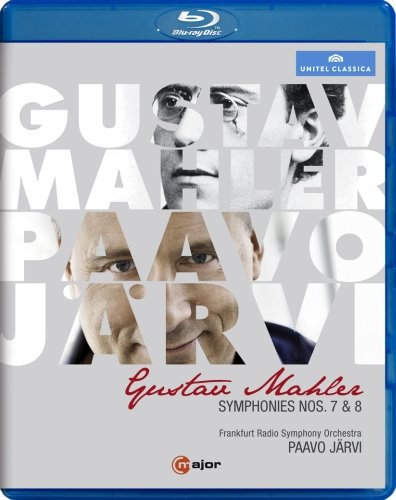MAHLER Symphonies Nos 7 & 8
View record and artist detailsRecord and Artist Details
Composer or Director: Gustav Mahler
Genre:
Orchestral
Label: C Major
Magazine Review Date: 07/2015
Media Format: Blu-ray
Media Runtime: 164
Mastering:
DDD
Catalogue Number: 729 604

Tracks:
| Composition | Artist Credit |
|---|---|
| Symphony No. 7 |
Gustav Mahler, Composer
Frankfurt Radio Symphony Orchestra Gustav Mahler, Composer Paavo Järvi, Conductor |
| Symphony No. 8, 'Symphony of a Thousand' |
Gustav Mahler, Composer
Ailish Tynan, Soprano Ain Anger, Bass Alice Coote, Mezzo soprano Anna Lucia Richter, Soprano Brno Philharmonic Chorus Charlotte Hellekant, Mezzo soprano Erin Wall, Soprano EuropaChorAcademie Frankfurt Radio Symphony Orchestra Gustav Mahler, Composer Limburg Cathedral Boys Choir Michael Nagy, Baritone Nikolai Schukoff, Tenor Paavo Järvi, Conductor |
Author: Peter Quantrill
Järvi is more convinced by Part Two, but I am not by his performance of it, or by his theory that Mahler’s setting of Goethe is an expression of the composer’s need ‘to be loved for what he is’. He adopts an arm’s-length approach to music that surely needs to be believed in if it isn’t to sound like an inflated if efficiently strung-together compendium of late-Romantic clichés.
This is a shame because on a technical level the Eighth is – as with all the other performances in the cycle – highly accomplished. Less so the filming: the cameras offer either close-up or side-on views of the soloists, and they could have made more of Järvi’s intelligent disposition of the two choirs either side of the organ console (the boys are placed in a side gallery to stage right) to illustrate Mahler’s neo-Handelian choral counterpoint; instead, close attention is paid to a particular blonde soprano in the front row. Each part is allotted only one track, and the applause is not tracked to the film: the place erupts in cheers as the soloists walk off the platform, which can’t be right.
The driving pulse to the Seventh’s first movement is superficially similar to that of the Eighth, but Järvi is much more comfortable with this symphony’s mutation of Baroque-shaped gestures into expressionist parodies of themselves: sarcasm over sincerity. Even the movement’s central idyll presses on as if trying to catch up with Webern’s Op 6 Pieces, and the Scherzo flashes by. Many of its extremes of dynamic and articulation are moderated in haste, though that impression may also be due to a compressed and spotlit sound mix from a hall in Wiesbaden that seems small for both the piece and the orchestra. Järvi even imparts a plausible urgency to the fourth-movement serenade by encouraging some tender phrasing outside a swift basic tempo, and the finale is a rococo riot which laughs in the face of good form and good taste. Overall the Seventh belongs with the other mid-period symphonies as the high point of the cycle.
Discover the world's largest classical music catalogue with Presto Music.

Gramophone Digital Club
- Digital Edition
- Digital Archive
- Reviews Database
- Full website access
From £8.75 / month
Subscribe
Gramophone Full Club
- Print Edition
- Digital Edition
- Digital Archive
- Reviews Database
- Full website access
From £11.00 / month
Subscribe
If you are a library, university or other organisation that would be interested in an institutional subscription to Gramophone please click here for further information.




